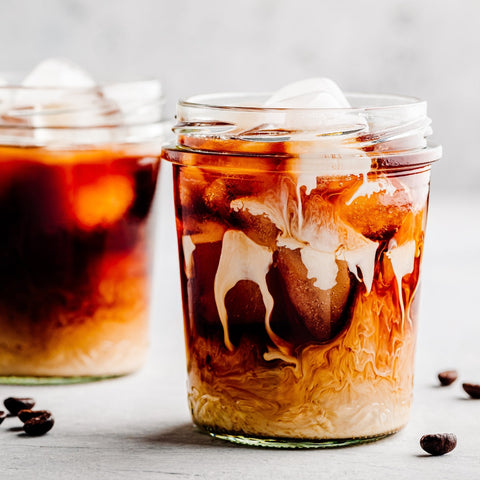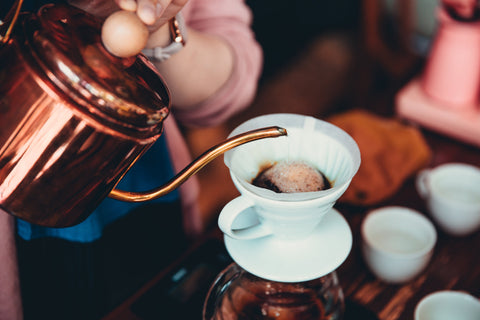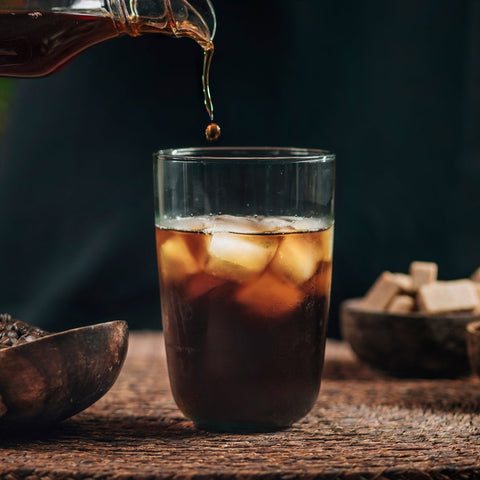Cold brew coffee has revolutionized the way we think about iced coffee, offering a smooth, less acidic alternative to traditional hot-brewed methods. Unlike regular iced coffee, which is hot coffee poured over ice, cold brew is made by steeping coarsely ground coffee in cold water for an extended period, typically 12-24 hours.
If you're wondering "how to make cold brew coffee without special equipment" or searching for "easy cold brew recipe for beginners," this comprehensive guide will walk you through everything you need to know about making cold brew coffee concentrate at home.
This brewing method extracts different compounds from the coffee beans, resulting in a concentrate that's naturally sweeter, smoother, and more caffeinated than hot coffee. According to the Specialty Coffee Association, cold brew's unique extraction process creates a fundamentally different flavor profile compared to traditional brewing methods. With the right technique and equipment, you can create café-quality cold brew in your own kitchen.
Why Choose Cold Brew Coffee?
Cold brew offers several advantages over traditional hot brewing methods. The extended steeping time at room temperature or in the refrigerator extracts fewer acidic compounds, making it easier on sensitive stomachs. Research published in the Journal of Food Science shows that cold brew coffee has significantly lower acidity levels than hot-brewed coffee. The result is a coffee concentrate that's naturally smooth and can be diluted with water, milk, or served over ice without becoming bitter or watery.
Many coffee enthusiasts ask "is cold brew stronger than regular coffee?" The answer is yes – the higher caffeine content makes cold brew an excellent choice for those who need an extra energy boost, while the concentrated nature means you can customize the strength to your preference. For those wondering "how long does homemade cold brew last," cold brew concentrate can be stored in the refrigerator for up to two weeks, making it perfect for meal prep enthusiasts.
Essential Equipment for Cold Brew Coffee
Creating exceptional cold brew starts with having the right tools. While you can make cold brew with basic kitchen equipment, investing in proper cold brew gear will significantly improve your results and streamline the process.
For those asking "what's the best cold brew coffee maker for home use," a dedicated cold brew maker or French press designed for cold extraction will provide better filtration and easier handling. If you're looking for "cheap cold brew equipment" or wondering "how to make cold brew without a coffee maker," mason jars work well for small batches, while larger cold brew systems are ideal for households that consume multiple cups daily. Fine-mesh strainers, cheesecloth, or paper filters are essential for achieving that smooth, sediment-free finish that characterizes great cold brew.
Temperature control is crucial, so having adequate refrigerator space or a cool, dark area for steeping is important. A kitchen scale for coffee brewing for measuring coffee and water ratios will ensure consistency in every batch you make.
Choosing the Right Coffee Beans
The foundation of exceptional cold brew lies in selecting quality coffee beans that complement the cold extraction process. Medium to dark roasts typically work best for cold brew, as they provide the rich, chocolatey notes that shine through the extended steeping time.
If you're wondering "what coffee beans are best for cold brew" or searching for "cold brew coffee beans recommendations," single-origin beans can offer unique flavor profiles, while blends provide consistency and balance. Look for beans with tasting notes of chocolate, nuts, caramel, or stone fruits, as these flavors are enhanced by the cold brewing process. Avoid beans with bright, acidic characteristics, as they may become overly sharp during the long extraction.
Freshness remains paramount – purchase whole beans and grind them just before brewing for the best flavor extraction. Learn more about coffee grinding techniques to perfect your cold brew preparation. The grind size should be coarse, similar to breadcrumbs, to prevent over-extraction and ensure proper filtration.
Step-by-Step Cold Brew Recipe
Ingredients:
- 1 cup coarsely ground coffee (about 85-90 grams)
- 4 cups cold, filtered water
- Ice for serving
- Milk or sweetener (optional)
Instructions:
Step 1: Prepare Your Coffee Measure out your coffee beans and grind them to a coarse consistency. The grind should resemble sea salt or breadcrumbs – too fine and you'll end up with over-extracted, bitter coffee that's difficult to filter.
Step 2: Combine Coffee and Water In your chosen brewing vessel, combine the ground coffee with cold, filtered water. Stir gently to ensure all grounds are saturated. The standard ratio is 1:4 (coffee to water), but you can adjust based on your strength preference.
Step 3: Steep Time Cover your brewing container and let it steep at room temperature for 12-24 hours. Shorter steeping times produce lighter, more acidic cold brew, while longer times create stronger, more concentrated results. Most home brewers find 16-18 hours provides the optimal balance.
Step 4: Strain and Filter After steeping, strain the coffee through a fine-mesh sieve lined with cheesecloth or a paper filter. For the smoothest results, strain twice – once through a coarse strainer to remove large grounds, then through a fine filter for sediment. Check out our guide on coffee filtration methods for more detailed straining techniques.
Step 5: Serve and Store Your cold brew concentrate is ready to serve. Dilute with equal parts water or milk, serve over ice, and customize with sweeteners as desired. Store remaining concentrate in the refrigerator for up to two weeks.
Perfect Cold Brew Ratios and Timing
Achieving the perfect cold brew depends on understanding the relationship between coffee-to-water ratio, grind size, and steeping time. The standard 1:4 ratio creates a strong concentrate that can be diluted to taste, while a 1:6 ratio produces a ready-to-drink strength.
For those who prefer stronger coffee, try a 1:3 ratio, but be prepared for a very concentrated result that requires significant dilution. Conversely, a 1:8 ratio creates a lighter, more tea-like beverage that can be enjoyed without dilution.
Steeping time affects both strength and flavor profile. Twelve hours produces a bright, acidic cold brew, while 24 hours creates a robust, full-bodied concentrate. Most coffee enthusiasts find 16-18 hours provides the optimal balance of strength and smoothness.
Common Cold Brew Mistakes to Avoid
Many home brewers make simple mistakes that can compromise their cold brew quality. Using the wrong grind size is the most common error – grounds that are too fine create over-extraction and difficulty filtering, while overly coarse grounds result in weak, under-extracted coffee.
Temperature control is crucial. While called "cold brew," the optimal steeping temperature is actually room temperature (around 70°F). Refrigerator temperatures slow extraction significantly, requiring longer steeping times or resulting in weaker coffee.
Poor filtration leads to muddy, sediment-filled cold brew that lacks the smooth mouthfeel that makes this brewing method special. Always use proper filtration methods and don't rush the straining process.
Over-steeping is another common mistake. While longer steeping times generally create stronger coffee, beyond 24 hours can lead to over-extraction and bitter flavors that defeat the purpose of cold brewing.
Flavor Variations and Customization
Cold brew's versatility makes it an excellent base for creative flavor combinations. During the steeping process, you can add whole spices like cinnamon sticks, cardamom pods, or vanilla beans to infuse additional flavors naturally.
Citrus peels, particularly orange or lemon, can add brightness without increasing acidity. Fresh mint leaves or lavender buds create aromatic variations perfect for summer drinking.
For chocolate lovers, adding cocoa nibs during steeping creates a natural mocha flavor without added sugars. Alternatively, a small amount of high-quality vanilla extract added to the finished concentrate provides dessert-like complexity.
Seasonal variations keep cold brew interesting year-round. Pumpkin spice blends work beautifully in fall, while peppermint or gingerbread spices create holiday-themed cold brew concentrates.
Storage and Serving Tips
Proper storage extends your cold brew's shelf life and maintains quality. Store concentrate in airtight glass containers in the refrigerator, where it will remain fresh for up to two weeks. Avoid plastic containers, which can absorb odors and affect flavor.
When serving, remember that cold brew concentrate is typically diluted 1:1 with water or milk, though personal preference should guide your ratio. Serve over ice in chilled glasses for the best experience. Explore our coffee serving accessories for the perfect cold brew presentation.
For entertaining, create a cold brew bar with various milk alternatives, sweeteners, and flavor additions. This allows guests to customize their drinks while showcasing your homemade concentrate.
Consider making ice cubes from cold brew concentrate to prevent dilution as ice melts. This maintains flavor intensity throughout the drinking experience.
Troubleshooting Your Cold Brew
If your cold brew tastes weak, the most likely culprits are insufficient coffee-to-water ratio, too coarse a grind, or inadequate steeping time. Adjust these variables gradually to find your perfect balance.
Bitter or over-extracted cold brew usually results from too fine a grind or excessive steeping time. Try coarser grinding and shorter steeping periods for your next batch.
Muddy or gritty cold brew indicates filtration issues. Ensure you're using proper filtration methods and consider double-straining for the smoothest results.
If your cold brew lacks flavor complexity, experiment with different bean varieties or try adding natural flavor enhancers during the steeping process. Visit our coffee troubleshooting guide for more brewing solutions.
Health Benefits and Considerations
Cold brew coffee offers several health advantages over hot brewing methods. The lower acidity makes it gentler on sensitive stomachs and dental enamel, while the higher caffeine content provides sustained energy without the jittery effects often associated with hot coffee.
The extended steeping time extracts more antioxidants and beneficial compounds from the coffee beans, potentially offering enhanced health benefits. Studies from Harvard Health Publishing indicate that coffee consumption, including cold brew, may be associated with various health benefits when consumed in moderation. However, the higher caffeine content means smaller serving sizes may be appropriate for caffeine-sensitive individuals.
Cold brew's naturally sweet flavor often requires less added sugar than hot coffee, making it a healthier choice for those watching their sugar intake. When diluted with unsweetened plant-based milks, it becomes an excellent option for various dietary preferences.
Conclusion
Making exceptional cold brew coffee at home is a simple process that rewards patience with smooth, flavorful results. With the right equipment, quality beans, and proper technique, you can create café-quality cold brew that rivals any commercial preparation.
The key to success lies in understanding the relationship between grind size, coffee-to-water ratio, and steeping time. Start with the basic recipe and adjust variables based on your taste preferences. For additional brewing insights, the National Coffee Association provides comprehensive guidelines for various coffee preparation methods. Remember that cold brew is forgiving – small adjustments can lead to significant improvements in flavor.
Whether you're a coffee enthusiast looking to expand your brewing repertoire or someone seeking a smoother, less acidic alternative to traditional hot coffee, cold brew offers a rewarding and delicious experience. With proper storage, one batch can provide multiple servings throughout the week, making it both convenient and economical.
References and Further Reading
- Specialty Coffee Association - "Cold Extraction Methods and Flavor Development"
- Journal of Food Science - "Chemical Analysis of Cold Brew Coffee"
- National Coffee Association - "Cold Brew Preparation Guidelines"
- Harvard Health Publishing - "Coffee and Health Research"
- Coffee Research Institute - "Brewing Methods and Extraction Science"
For more coffee brewing guides and equipment reviews, explore our complete collection of coffee resources and discover the perfect tools for your home brewing setup.



